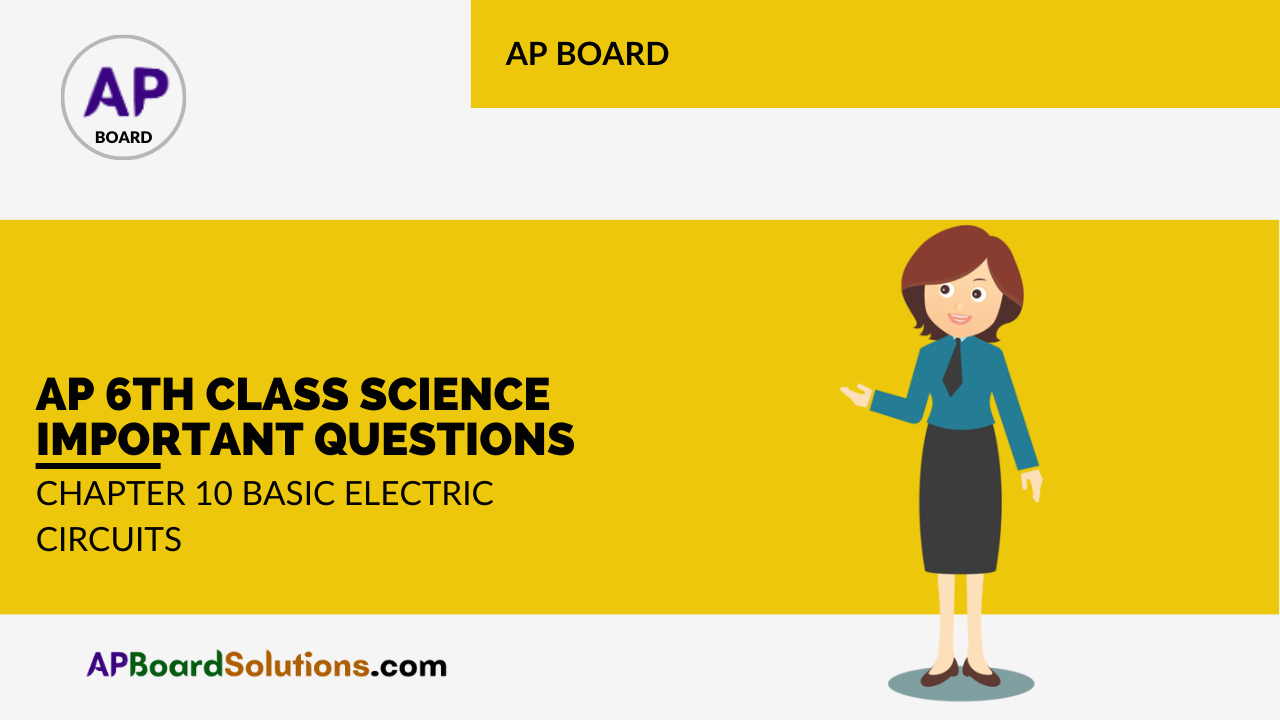These AP 6th Class Science Important Questions 10th Lesson Basic Electric Circuits will help students prepare well for the exams.
AP State Syllabus 7th Class Physical Science 10th Lesson Important Questions and Answers Basic Electric Circuits
6th Class Science 10th Lesson Organisms and Habitat 2 Mark Important Questions and Answers
Question 1.
What does a cell contain?
Answer:
A cell contains some chemical substances which can produce electricity with two terminals.
Question 2.
Many times in our houses we observe that though electricity is available some bulbs glow and some don’t glow. What could be the reason for that?
Answer:
The filament might have been fused off.
Question 3.
What is current?
Answer:
The flow of electricity in a circuit is called current.
![]()
Question 4.
Do not connect the two terminals of a cell with a single wire. Give reason.
Answer:
- We should never connect the two terminals of a cell with a single wire.
- If we do so, the chemicals in the cell get used up very fast and the cell stops working.
Question 5.
What is filament?
Answer:
The part of the bulb that glows is the filament, which is a thin spring-like wire attached to the two metal wires inside the glass bulb.
Question 6.
What is the switch?
Answer:
The switch is a device used to close or open an electric circuit.
Question 7.
What is the purpose of a switch?
Answer:
We use switches to put ON or put OFF the torchlight.
Question 8.
Is our body insulator or conductor?
Answer:
Our body is a good conductor of electricity.
Question 9.
Why is the handle of the electrician’s screwdriver made of plastic?
Answer:
- Plastic is a bad conductor and does not allow current to pass through it.
- So, the electrician has a plastic handle to protect him from any shock.
![]()
Question 10.
What is the difference between our present bulbs and the Edison bulb?
Answer:
- Today we use the same kind of bulbs as were first made by Edison.
- The only difference is that our bulbs have a filament made of a metal called Tungsten.
6th Class Science 10th Lesson Organisms and Habitat 4 Mark Important Questions and Answers
Question 1.
What is the use of a switch in a circuit?
Answer:
- The switch allows the flow of electricity when it is ON and cuts off the flow of electricity when it is OFF.
- In this way, the switch is used to allow / stop the flow of electricity to the bulb or any other electrical device.
Label the parts in the following figure.
Question 2.
Label the parts in the following figure.
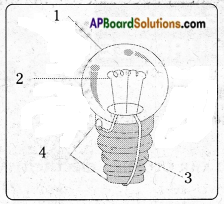
Answer:
1. Glass chamber
2. Filament
3. Metal cap
4. Terminals
Question 3.
Match the following by seeing the figure.


Answer:
a – q,
b – r,
c – s,
d – p
![]()
Question 4.
Observe the following figure.
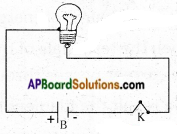
Does the bulb glow or not? Why?
Answer:
- Yes, the bulb will glow.
- Since the connections are
perfectly done in the closed circuit.
Question 5.
Observe the following figure.
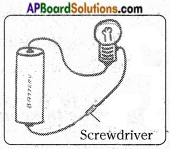
Does the bulb glow or not in the arrangement which shown in figure? Why?
Answer:
- No, the bulb will not glow.
- Here in this arrangement the circuit is not completed.
- The handle of the screw is an insulator.
Question 6.
Would the bulb glow in the circuit shown in figure? Why?
Answer:
- No, the bulb will not glow.

- This is because an electric bulb glow up only when circuit is completed and eraser is a non – conducting material.
Question 7.
Give reasons for the following:
a) Electric wires are made of copper.
b) We should not operate electric switches with wet hands.
Answer:
a) Copper is a good conductor of electricity.
b) Water is a good conductor of electricity and we might get an electric shock.
![]()
Question 8.
What was the story of the bulb ? Who ultimately succeeded in making the first bulb?
Answer:
- The story of invention of bulb is very interesting.
- We may think that a bulb is a very sinjple gadget, just press a switch and it lights up.
- But many scientists worked hard for many years before the first successful bulb was made.
- One of them was Thomas Alva Edison who ultimately succeeded in making the first bulb.
Question 9.
What was the nature of Thomas Alva Edison?
Answer:
- From childhood, Edison was of an inquisitive nature and he learned science by performing experiments himself.

- We will be amazed to know that in his life time he invented more them one thousand inventions.
- Even an intelligent scientist like Edison had to work hard for many years before he could make a bulb that worked.
Question 10.
Why do bulbs and cells have two terminals?
Answer:
- Current needs a closed path in order to flow.
- To form a closed path there should be two terminal – one for inlet and another for an outlet.
- So in order to complete the circuit bulbs and cells have two terminals.
![]()
Question 11.
How does a bulb glow with the help of a cell?
Answer:
- Cell is the source of energy that produces electricity from the chemical stored inside it.
- When the terminals of the bulb are connected with that of the electric cell by wires, the current passes through the filament of the bulb.
- As a result the filament gats heated up and emits the light.
- This makes the bulb glow.
6th Class Science 10th Lesson Organisms and Habitat 8 Mark Important Questions and Answers
Question 1.
Describe the construction of a torch-bulb.
Answer:
- A torch bulb consists of a glass chamber fixed on a metal base.
- Two metal wires are firmly fixed.
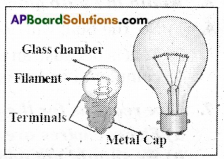
- One wire is attached to the metal cap and the other is attached to the base at the center of the metal cap.
- These wires act as two terminals. The two terminals do not touch each other.
- The part of the bulb that glows is the filament, which is a thin spring-like wire attached to the two metal wires inside the glass bulb.
Question 2.
How do you test when the electric bulb glows with a cell? Describe the activity you do with simple electric circuits.
Answer:
Aim: To test when do the electric bulb glows with a cell.
What do you need? (Materials required): Four wires of different colors each about 15 cm long, a bulb, a cell, a cello-tape or cell-holder
How to do? (Procedure):
- Take four wires of different colors, say blue, green, red and yellow, each about 15 cm long.
- Electric wires are often covered with plastic. First, remove about two centimeters of the plastic covering, from both ends of each wire.
- Now attach two wires (Blue and Green) to a bulb and two Wires (Red and Yellow) to a cell with a cello-tape or cell-holder as shown in Fig.
- We can use a cell holder to hold the cells and wires together tightly.
- Now connect the wires in different forms as shown in Fig. 4(b) to 4(g).
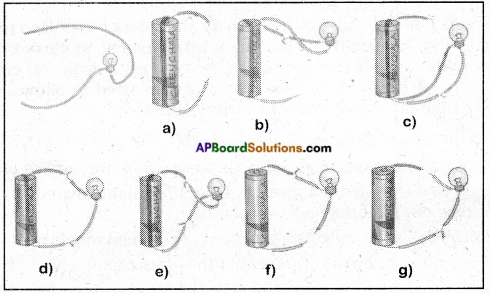
- In each case, check whether the bulb glows or not.
- Record your observations in the table.
Connection Does the bulb glow (Yes / No) Fig (b) No Fig (c) No Fig (d) Yes Fig (e) Yes Fig (0 No Fig (g) No
What do you see? (Observation): You may observe that the bulb glows in connections shown in Fig. 4(d) and Fig. 4(e), but not in other cases.
What do you learn? Result: We noticed that in Fig. (d) and Fig. 4(e) the connections form a closed path while in the remaining cases we find some gap in the path.
![]()
Question 3.
Write an activity showing the working of a switch in a circuit.
Answer:
Aim: To show the working of switch in a circuit.
What do you need? (Materials required: a cell (power source, a bulb, connecting wires, wooden plank or thermocol sheet, two drawing pins, and the materials provided to test.
How to do it? (Procedure):
- Connect à èirÙit on a wooden plank or on a thermocol sheet as shown in Fig.
- Insert two drawing pins at A and B.

- Insert a safety pin in between A and B, such that one end of the pin is completely in contact wLth Rand the other end is left free.
- Now observe the bulb.
- Now touch the safety pin to pin A and observe the bulb again
What do you see? (Observation): The bulb doesn’t glow when the safety pin left free at one end. But it glows when the safety pin touches pin A.
What do you learn? (Result): In this activity, the safety pin is used to close /open the circuit. Similarly, An electric switch is an arrangement to close or open (break) a circuit. The switch allows the flow of electricity when it is on and cuts off the flow of electricity when it is off. In this way, the switch is used to allow/stop the flow of electricity to the bulb or any other electrical device.
Question 4.
Describe the trials of Edison to make a bulb.
Answer:
- First of all, Edison passed electricity through a thin, thread-like platinum wire.
- He noticed that the wire did give out the light after being heated, but it burned out after only a few seconds.
- He made a glass casing and fitted a filament of platinum wire in it.

- He then removed all the air from within the glass casing.
- He passed an electric current through the wire and, to his delight, the bulb lit up and did not burn out for eight long minutes.
- He began experimenting with different materials while searching for a better choice of filament.
- He tried cotton thread coated with soot. This filament burned continuously for 45 hours.
- He tried different kinds of thread.
- Finally, he succeeded in making a cotton filament that was even better than the bamboo one.
![]()
Question 5.
Label the parts 1, 2, 3, 4, 5, 6, 7 and 8 in Torchlight.
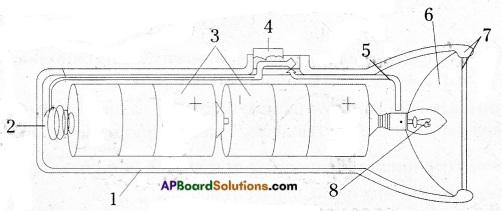
Answer:
- Hollow cylindrical barrel
- Metal spring
- Cells
- Switch
- Copper wire
- Reflector
- Glass
- Bulb
Question 6.
Observe the given diagram.
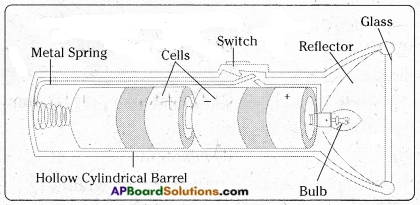
Now answer the following questions.
- In a bulb which part gives us light?
- What is the use of a switch in a circuit?
- What is the filament made of?
- What does a torch consist of?
- What is a source of electrical energy in a torchlight?
- Which of the following acts as the negative terminal of a torchlight?
Answer:
- Filament.
- The switch helps us to allow or break the flow of current in a circuit.
- Tungsten.
- Torchlight consists of a cell, bulb, and switch.
- Cell.
- Zinc plate or Zinc container.
